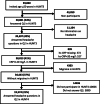High sensitivity C-reactive protein and risk of migraine in a 11-year follow-up with data from the Nord-Trøndelag health surveys 2006-2008 and 2017-2019
- PMID: 32503410
- PMCID: PMC7275479
- DOI: 10.1186/s10194-020-01142-1
High sensitivity C-reactive protein and risk of migraine in a 11-year follow-up with data from the Nord-Trøndelag health surveys 2006-2008 and 2017-2019
Abstract
Background: Several previous studies have reported a cross-sectional association between elevated high sensitivity C-reactive protein (hs-CRP) and migraine. The aim of this population-based follow-up study was to investigate the influence of hs-CRP at baseline on the risk of developing migraine 11 years later.
Methods: Data from the Nord-Trøndelag Health Study performed in 2006-2008 (baseline) and 2017-2019 were used. A total of 19,574 participants without migraine at baseline were divided into three groups based on hs-CRP levels (< 3 mg/L, 3-9.99 mg/L and 10.00-20 mg/L). Poisson regression was used to evaluate the associations between hs-CRP levels and risk ratios (RRs) of migraine, and precision of the estimates was assessed by 95% confidence interval (CIs).
Results: In the multi-adjusted model, increased risk of migraine (RR 1.46, 95% CI 1.05-2.04) was found in the highest hs-CRP levels group compared to the lowest group. In the group with the highest hs-CRP levels, a nearly three times higher risk of chronic migraine (RR 2.81, 95% CI 1.12-7.06) was found, whereas no evident relationship was found between high hs-CRP level and risk of developing episodic migraine.
Conclusions: The main finding in this 11-year follow-up was that hs-CRP levels between 10.00-20.00 mg/L at baseline was associated with increased risk of chronic migraine.
Keywords: Epidemiology; Follow-up; General population; Inflammation; Migraine.
Conflict of interest statement
None of the authors have any competing interests in the manuscript.
Figures
Similar articles
-
Time trends of major headache diagnoses and predictive factors. Data from three Nord-Trøndelag health surveys.J Headache Pain. 2020 Mar 11;21(1):24. doi: 10.1186/s10194-020-01095-5. J Headache Pain. 2020. PMID: 32160857 Free PMC article.
-
The impact of C-reactive protein levels on headache frequency in the HUNT study 2006-2008.BMC Neurol. 2019 Sep 26;19(1):229. doi: 10.1186/s12883-019-1462-8. BMC Neurol. 2019. PMID: 31558164 Free PMC article.
-
Does insomnia modify the association between C-reactive protein and migraine? The Tromsø Study 2015-2016.Cephalalgia. 2019 Jul;39(8):1022-1029. doi: 10.1177/0333102418825370. Epub 2019 Mar 12. Cephalalgia. 2019. PMID: 30862180
-
Hs-CRP and all-cause, cardiovascular, and cancer mortality risk: A meta-analysis.Atherosclerosis. 2017 Apr;259:75-82. doi: 10.1016/j.atherosclerosis.2017.02.003. Epub 2017 Feb 9. Atherosclerosis. 2017. PMID: 28327451 Review.
-
C-reactive protein and migraine. Facts or speculations?Clin Chem Lab Med. 2014 Sep;52(9):1265-72. doi: 10.1515/cclm-2014-0011. Clin Chem Lab Med. 2014. PMID: 24717337 Review.
Cited by
-
C-Reactive Protein: Pathophysiology, Diagnosis, False Test Results and a Novel Diagnostic Algorithm for Clinicians.Diseases. 2023 Sep 28;11(4):132. doi: 10.3390/diseases11040132. Diseases. 2023. PMID: 37873776 Free PMC article. Review.
-
Exploring the Causal Relationship Between Migraine and Insomnia Through Bidirectional Two-Sample Mendelian Randomization: A Bidirectional Causal Relationship.J Pain Res. 2024 Jul 16;17:2407-2415. doi: 10.2147/JPR.S460566. eCollection 2024. J Pain Res. 2024. PMID: 39050680 Free PMC article.
-
Assessing the Effect of Zinc Supplementation on the Frequency of Migraine Attack, Duration, Severity, Lipid Profile and hs-CRP in Adult Women.Clin Nutr Res. 2021 Apr 27;10(2):127-139. doi: 10.7762/cnr.2021.10.2.127. eCollection 2021 Apr. Clin Nutr Res. 2021. PMID: 33987139 Free PMC article.
-
Comorbidities as risk factors for migraine onset: A systematic review and three-level meta-analysis.Eur J Neurol. 2025 Mar;32(3):e16590. doi: 10.1111/ene.16590. Eur J Neurol. 2025. PMID: 40040320 Free PMC article.
-
Telomere length exhibits inverse association with migraine among Americans aged 20-50 years, without implications beyond age 50: a cross-sectional study.Sci Rep. 2024 Sep 30;14(1):22597. doi: 10.1038/s41598-024-72675-7. Sci Rep. 2024. PMID: 39349547 Free PMC article.
References
-
- Lippi G, Mattiuzzi C, Cervellin G. C-reactive protein and migraine. Facts or speculations? Clin Chem Lab Med. 2014;52:1265–1272. - PubMed
MeSH terms
Substances
LinkOut - more resources
Full Text Sources
Medical
Research Materials
Miscellaneous


